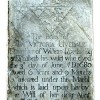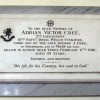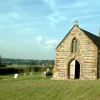It was a cold and miserable day that greeted the people of Weymouth as theyawoke on the morning of March 3rd, 1645. They would have seen the Parliament Navy’s ship the ‘James’ anchored in the bay, dark clouds hanging low over it. Soon after daybreak Captain William Batten, Vice-Admiral of the Parliament Navy, came ashore and together with his officers marched straight to the Nothe; on the way he was joined by William Sydenham, the Parliamentary Governor and his garrison officers. Many of the battle fatigued half starved men of the town trailed along behind them through their ruined town.
The gallows loomed large in everyone’s view summoning John Mills , who had been the Town Constable and Captain John Cade a Royalist sea captain, and Walter Bond, a local tailor. All three were charged with treachery. Mills and Cade were hanged but the penitent tailor, described as being “full of confession and sorrow “, was reprieved and returned to Marshallsea, the prison within the Nothe fort. Another man did not wait to be dragged through the streets to meet his end, choosing to hang himself. No-one knew his name but he was thought to be an “Irish rebel – a native Papist”. Fabian Hodder one of the instigators of the plot to secure the town for the king, was not hanged; he was in prison at Poole. Hodder survived and following the Restoration became a member of the Corporation of Melcombe Regis.
By Christmas 1644 there were few men in Weymouth who supported the Royalist cause; indeed Weymouth had little to thank either the King or Cromwell for. Fabian Hodder was a prominent merchant in the town, and was plotting with Sir William Hastings, Royalist Governor of Portland, to take Weymouth for the king.
The plan was for Portlanders to attack along the beach road while cavalry under Sir Lewis Dyves, Commander in Dorset for the King, would attack the town’s inland defences. Hodder, Mills, Cade and other Royalists in Weymouth would rise-up when the attacks started at midnight on February 9th 1645, but Hodder found he had over-estimated the support for the king. He went about the town offering men £5 if they would join him and those that took the money were made to swear an oath: “You shall swear by the Holy Trinity that you will conceal the intended plot”. The password for the royalist conspirators within the town was Crabchurch and they were told to wear a white handkerchief on their arm.
It had been a hard winter but militarily a quiet one. Peter Ince, the Minister appointed by Parliament, wrote: “In the beginning of February we were in as sweet and quiet security as any garrison in the Kingdom. No enemy near us but one at Portland, and they not very considerable, being about 300 or 400 men”.
Fabian Hodder’s wife Anne wrote the letter that was sent to Sir Lewis Dyves at Sherborne and it was another woman, a widow, (Elizabeth Wall), who undertook the dangerous mission to deliver it to Sherborne, a distance of some nineteen miles.
Battles rarely proceed according to plan and this proved to be no exception. John Cade visited Fabian Hodder just four hours before midnight and was told Sir Lewis Dyves and his cavalry would attack at midnight. Earlier at a church service on Portland the islanders and the King’s troops were told to be at Portland Castle at five o’clock. This was going to be a two pronged attack: one along what was then a quiet country road and the second group were to move by boat to the pier under the Nothe guided in by Walter Bond. Marching along the beach road the Portlanders were met at ‘The Passage’ (there was no bridge) by John Dry, a Weymouth tanner, who led them to the Chapel Fort on the heights of Chapelhay.
Amongst the Parliamentarians within the fort, most of whom were asleep; there was more than one man who had taken Hodder’s money. The men of Portland attacked from the rear and from the harbour but within the hour the Roundheads counter attacked but failed to re-take the Chapel Fort. It was here that Major Francis Sydenham lost his life – he was the Governor’s brother.
Chapel Fort commanded the harbour, the town and much of the Bay. Nothe Fort and a smaller fort at Bincleaves were soon captured. Parliamentary troops still remained in Weymouth and suffered from the Royalist guns which fired upon them from the heights of Chapelhay.
The attack by the Portland men was the only attack that night. Dyves did not keep his promise to march on Sunday. It was not until the following day that Dyves’ 1,500 horse and foot battled their way into Weymouth forcing the Roundheads to retreat to Melcombe, raising the drawbridge between the two towns as they left.
Two miles away at Radipole Meadow, Mr Wood, Curate of Sutton Poyntz and about thirty other men, most of them armed only with cudgels, had waited all night for the arrival of the King’s cavalry. Brought before a Parliament Council of War, they pleaded “We waited and went home”. They were fortunate.
From the Chapel Fort the Royalist guns thundered down on around 900 Roundheads trapped in Melcombe surrounded by more than 4,000 Royalists. Thatched houses were set alight as fire balls, bolts and bars rained down on the town. It seems William Sydenham might have been close to surrendering when he said “Let us cease this useless burning”. The King’s man, Dyves, replied “We scorn to parley with you.” After that exchange Sydenham sent out a patrol that burnt eight more houses and a Royalist ship in the harbour.
A jubilant Dyves arrogantly certain that this time the Royalists would hold Weymouth and confidently expected to capture all of Melcombe, but could the tide of events be about to turn? Vice Admiral Batten brought two Parliamentary ships into the bay and landed two hundred of the toughest fighting men in the Dorset campaign and Lieut. Colonel James Haymes arrived with one hundred men.
On his way from mid-Dorset was Lord Goring, the King’s Lieutenant in Hampshire; with him 3,000 horse, 1,500 foot and an artillery train. On February 23rd Goring unleashed this overwhelming force against the 900 Roundheads in Melcombe but Sydenham did not surrender.
William Sydenham’s men captured twenty-five Royalist cavalry on February 25th. The Cavalier Dyves watched from his vantage point high above the town at Chapelhay and ordered 100 Foot to rescue the prisoners. The hard pressed Sydenham countered by sending 150 musketeers to attack the Chapel Fort. These men were led by Major Wilson and Captain Langford and to the heights of Chapelhay they climbed, stormed the fort taking more than 100 officers, soldiers and “some perfidious townsmen”.
The Royalists had held Chapel Fort for 17 days. With their superior numbers it is surprising they were beaten but the facts of their defeat suggest a lack of enthusiasm amongst the troops, perhaps aggravated by an arrogant and cavalier style of leadership. On February 27th Lord Goring unsuccessfully fought to regain the fort and suffered heavy losses. The following day Dyves and Goring heard that Sir William Waller was marching towards Weymouth. Goring withdrew his men to Wyke where his they rested while his wounded were patched-up before marching off to Taunton. The Royalist troops holed-up in the smaller forts of Nothe and Bincleaves – which had not been attacked –appear to have left in a hurry leaving their colours and most of their guns.
At the end of all the fighting the people of Weymouth and Melcombe were left ragged, hungry and filthy. Their towns in ruins, the narrow streets lined with their demolished homes and burnt timbers were scattered all about the place.
“My soldiers, Horse and Foot, have all had very hard service of it day and night. I shall entreat you to write to the Parliament for something for their encouragement; they have neither money nor clothes, and yet unwearied in thisbusiness”, wrote William Sydenham.



